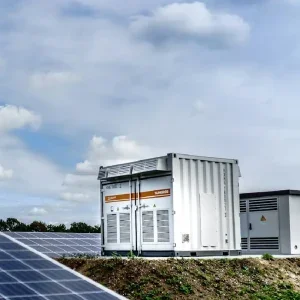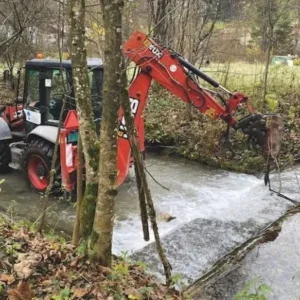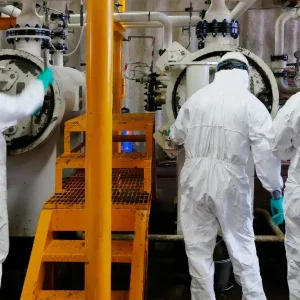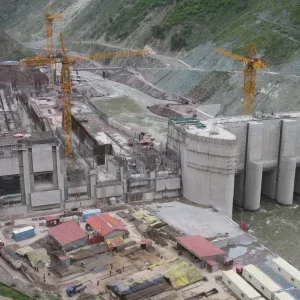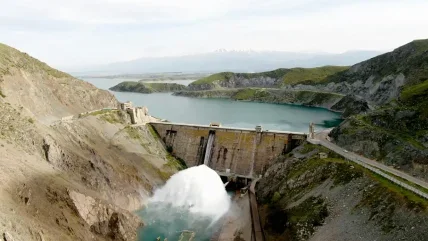
The Kashimbila Multipurpose Dam project has been commissioned in Nigeria’s Taraba State. Its primary purpose is to offer protection against the discharge of water from Lake Nyos, a structurally weak and toxic lake situated along volcanic lines of neighbouring Cameroon Republic – the potential collapse of which could result in catastrophic flooding, endangering the lives and properties of millions of people. However, to maximise the benefits of the Kashimbila ecosystem, the project’s engineering design also incorporated a 40MW hydropower station, a water supply scheme with a capacity of 60,000m3 per day, a 2000-hectare irrigation system, an airstrip, fishing activities, and tourism prospects.
Highlighting the government’s commitment to uplifting Nigerians out of poverty, creating employment opportunities, and enhancing the overall standard of living, President Buhari says that projects like Kashimbila align with the country’s poverty alleviation policies. They are also part of Nigeria’s dedication to achieving its ambitious plan to supply 30GW of electricity by 2030, with renewable energy accounting for at least 30% of the energy mix.
GE Vernova’s Hydro Power business has also successfully completed the commissioning of four 175MW Francis hydropower turbines and generators at Nigeria’s Zungeru project in Niger State. This development marks a significant milestone for the project, located along the Kaduna River, and establishes it as Nigeria’s second-largest hydropower plant with a total capacity of 700MW.
The Zungeru project holds the promise of contributing to approximately 10% of Nigeria’s domestic electricity requirements, providing a substantial boost to the country’s energy needs with a focus on sustainability and reliability. It will also play a vital role in flood control and support for regional irrigation efforts.
“Nigeria is gifted with large rivers and natural falls that create opportunities for hydropower development,” says Brian Selby, Hydro Power Asia Leader at GE Vernova. “As the government of Nigeria continues to pursue the expansion of generation capacity and extend the capability of its power grid, we are happy to help take advantage of the country’s water reserves to meet its increasing demand for sustainable, reliable, and efficient power. This project will have a wide-reaching impact on the country’s energy landscape.”
With its hydropower potential estimated at over 14GW, the International Hydropower Association has previously highlighted the vital role hydro can play in Nigeria’s energy transition.
Boosting Mexico’s hydropower
The Multilateral Investment Guarantee Agency of the World Bank (MIGA) has issued a guarantee aimed at enhancing Mexico’s hydropower capacity. The guarantee is in connection with Mexico’s state-owned integrated electric utility, Comisión Federal de Electricidad (CFE), and is pivotal in backing the repowering and substantial upgrade works on seven of its ageing hydroelectric plants. Projected to increase capacity by an estimated 113MW and generate nearly 1500GWh of electricity annually, the upgrades will help meet Mexico’s anticipated annual increase in electricity demand of 2.5% between 2023 and 2037.
“By contracting long-term financing in favourable conditions through the MIGA guarantee, CFE will be able to extend the useful life of its hydroelectric plants and increase its renewable generation capacity,” Manuel Bartlett, CEO of Comisión Federal de Electricidad said, highlighting that this will also contribute significantly to reduce greenhouse gas emissions and accelerate Mexico’s energy transition.
In 2022, the country’s 12.6GW of installed hydropower capacity, primarily owned and operated by CFE, accounted for approximately 10.5% of electricity production.
Brazilian renovation
Andritz has secured a contract from Engie Brasil Energia for the comprehensive modernisation of the 424MW Jaguara hydropower plant in Rifaina, Sao Paulo. The plant is a pivotal component of Engie’s hydro generation portfolio and has been in uninterrupted operation since its inception in 1971.
Slated for completion by the close of 2028, the project is set to encompass an extensive overhaul of the plant’s core components. Andritz’s scope of work entails the modernisation of all four 106MW Francis turbine generator units but will also encompass the refurbishment of governors, the excitation system, the automation system, as well as all associated auxiliary systems.
Indian insights
THDC India Limited has finalised a Memorandum of Agreement for the implementation of the 1200MW Kalai-II hydroelectric project in the Anjaw District of Arunachal Pradesh.
Highlighting the project’s contribution to the nation’s green energy goals, the Kalai-II project is expected to generate 4852.95 million units annually, aligning with the national target of increasing the share of green energy in the overall energy mix.
Meanwhile, in Sikkim, flash flooding during October 2023 overtopped the Teesta V dam, resulting in significant damage and interruption to power production. Ongoing construction of the 500MW Teesta VI hydro project was also disrupted by the flooding.
While the Teesta Low Dam – III Hydropower Plant (TLDP-III) and TLDP-IV, both located in downstream West Bengal, did not suffer major damage, they were shut down due to heavy siltation brought by the floodwaters. No damage was reported in the Rangit valley, where NHPC’s Rangit IV power project and Rangit Power Station are situated.
Mexican shortages
According to news reports from Reuters, frustrated Mexico City residents have been protesting about water shortages as officials warn of “unprecedented” low supplies. One of Latin America’s largest cities, the area is home to over 21 million people and has been struggling after years of low rainfall blamed on climate change, along with unprecedented urban growth and outdated infrastructure.
Protesters have allegedly broken into offices of Mexico’s National Water Commission, while some residents say they have been without water for more than a month and others have started fighting over limited supplies.
SACMEX, Mexico City’s water utility says that the Cutzamala System is the most stressed it has ever been. A network of pumping plants, dams, and other infrastructure, it provides water for more than six million people and was at 39.7% capacity at the end of January 2024, down from about 41% in December and 54% in 2023. According to atmospheric scientists from the National Centre for Atmospheric Research in Colorado, the city’s depleted reservoirs won’t be able to refill until the summer months.
South African water supplies
Amid water scarcity concerns experienced in some parts of the province, reports issued by South Africa’s Department of Water and Sanitation (DWS) in February has shown that the overall water storage capacity in KwaZulu-Natal was stable at 89.3%.
The province’s main water supply, the Umgeni River, provides water to five dams. One of the largest in KwaZulu-Natal, the Albert-Falls Dam, has remained at 100% full capacity. Hazelmere Dam which provides water to the province’s North Coast was slightly down at 82.8% which is still a significant improvement when compared to 2023, when during a similar period the dam stood at 55.5%.
While most of KwaZulu-Natal’s storage capacity has recorded above average percentages, the DWS acknowledges that some communities are experiencing water shortages, and it will continue to work to find permanent solutions to the challenges.
Measures being implemented include fast-tracking the roll out of bulk water infrastructure projects, such as the raising of the Hazelmere Dam wall which was completed last year. Another project is the uMkhomazi Water Project which entails the construction of a new large dam on the uMkhomazi River, a 33km tunnel and pipelines to supply additional water to eThekwini and surrounding municipalities across the province.
Concern has also been expressed over in the Western Cape Province, where there has been a slight decline on the river catchment systems. “The sweltering high temperatures we have experienced combined with high water usage in recent weeks has contributed to the slight decline of the dam levels in the province” says DWS Western Cape Provincial Head Bila-Mupariwa. He reiterated that South Africa is a water-scarce nation receiving insufficient and unreliable rainfall and called for renewed efforts to use water sparingly.
This article first appeared in International Water Power Magazine.


